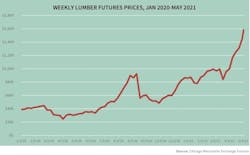Lumber prices have been especially volatile amid the COVID-19 pandemic. Increased demand and supply-side constraints have pushed prices up more than 200% in the past year.
While the housing sector continues to be a leader in the nation’s economic recovery, these sharp price increases threaten the residential construction industry’s ability to lead the economic recovery and meet the nation’s strong demand for new homes. The lumber price crisis is also making it more difficult for builders to deliver housing that is affordable to low- and moderate-income households.
Soaring lumber prices that have tripled over the past 12 months have caused the price of an average new single-family home to increase by almost $36,000, according to analysis by the NAHB Economics team. This lumber price hike has also added nearly $13,000 to the market value of an average new multifamily home, which translates into households paying roughly $119 a month more to rent a new apartment.
John Barrows, founder of P3 Builder Group Inc. in Bridgehampton, N.Y., offered some of the lessons he has learned about dealing with high materials costs, including lumber, in a recent Building Knowledge session during the virtual International Builders’ Show, IBSx.
One of Barrows’ most important lessons learned? Use an escalation clause.
“The most important thing to have is an escalation clause. You should put one in your contract, pandemic or no pandemic,” Barrows said, noting the extreme volatility in building materials like lumber. The clause states that if prices for certain component building materials rise after execution of a contract, the client agrees to pay that cost increase to the builder.
Equally as important, notes Barrows, is “buying out the job” – or ordering everything you can at contract signing. A practice he says makes sense at any time since it assures costs won’t escalate dramatically as a project progresses. It’s also important to identify long lead time items, many of which showed even longer delivery delays this year due to supply chain issues caused by the pandemic.
The issue of new home appraisals has also become a growing concern, as existing standards can make it difficult to acknowledge the impact of higher materials prices in the valuation of new homes. NAHB wants to make sure builders understand that it is acceptable for a builder to speak with the appraiser and provide relevant information needed to accurately assess a home’s value.
Home builders are encouraged to ask the appraiser to use the cost approach. In this method, the appraiser estimates what it would cost to rebuild or construct an equivalent structure. Because this component of valuation considers the costs of materials used to construct the property, it can be helpful in analyzing the value of a newly constructed home.
It is important to keep in mind that the cost approach is always used in combination with the sales comparison approach, and that more weight is given to the sales comparison method, in line with guidance from Fannie Mae and Freddie Mac.
An outline for an “appraisal binder” as well as sample escalation clauses are available at nahb.org/lumber. Other resources designed to help builders deal with shortages and high prices of lumber and other building materials are also available online.
While no one expects another full-blown global pandemic anytime soon, the lessons builders have learned over the past year can help them to deal with the unexpected. NAHB will continue working on behalf of its members and the industry to address supply shortages that can harm small businesses, home building, and the overall economy.
NAHB Focus on Lumber
Escalating lumber prices are driving up housing costs and slowing new home production. This is the most critical issue facing our industry today.
Insufficient domestic production and curtailments by large lumber mills that have lingered throughout the past year are the biggest problems. NAHB is working hard to identify solutions to the crisis. Actions NAHB is taking include:
- Reaching out to the Biden administration calling for prompt action on the issue.
- Leading an effort by more than 35 organizations asking Commerce Secretary Gina Raimondo to examine the lumber supply chain and work to increase production.
- Urging U.S. trade officials to return to the table and negotiate a new softwood lumber agreement with Canada.
- Tracking prices weekly and conveying the message to the public through news media outlets, social media, on nahb.org and the NAHBNow blog.
- Meeting with members of Congress in their home districts to “Bring Housing Home” and relay the message that high prices are hurting small businesses, consumers and the broader economy.
- Requesting that Congress consider ways to boost the domestic supply of timber from public lands.
- Targeting advertisements to domestic producers featuring member testimonials on the impact of high prices.
- Conducting economic research showing the effect soaring prices are having on the price of a new home.

